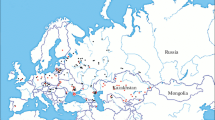Summary
The cercariae of Echinochasmus zubedakhaname n.sp. on emerging from the snail first intermediate host, Pomacea glauca, both in natural and experimental conditions, encyst in the intestinal mesenteries of the fish, Lebistes reticulatus. The cysts from these fish when fed to pigeons and chickens develop, in the small intestine, into adult echinostomes with the expulsion of echinostome eggs in feces after the seventh day of the experimental infection. The adults possess a crown of 20 collar spines interrupted dorsally in oral region while no such spines exist in the cercariae. The natural definitive host is an avian species, Fluvicola pica. The cercaria is devoid of a finfold on its tail and the contents of its cystogenous glands are rhabditiform.
Zusammenfassung
Die Cercarien von Echinochasmus zubedakhaname n.sp., die aus der Schnecke Pomacea glauca als ersten Zwischenwirt ausschlüpft, encystieren sowohl unter natürlichen als auch experimentellen Bedingungen in den Mesenterialgefäßen des Fisches Lebistes reticulatus. Wenn die Cysten aus diesen Fischen an Tauben und Küken verfüttert werden, entwickeln sie sich zu adulten Echinostomen, deren Eier am 7. Tag nach der experimentellen Infektion in den Faeces erscheinen. Die Adulten besitzen einen Kranz von 20 Kragen-Dornen, der dorsal in der Mundregion unterbrochen ist; die Cercarien besitzen keine solche Dornen. Natürlicher Endwirt ist die Vogelart Fluvicola pica. Die Cercarien besitzen einen ungegabelten Schwanz; der Inhalt der cystogenen Drüsen ist stäbchenförmig.
Similar content being viewed by others
References
Beaver, P. C.: The life history of Echinochasmus donaldsoni n.sp., a trematode (Echinostomatidae) from the pied-billed grebe. J. Parasit. 27, 347–355 (1941).
Cable, R.: An illustrated manual of Parasitology. Minneapolis: Burgess Publishing Co. 1964, 165 pp.
Issaitschikoff, I.: Novia trematoda roda Echinochasmus Dietz, Parazitiruiuschaia v. Kishechnike ptits. (Ein neuer saugwurm der Vögel aus der Gattung Echinochasmus.) Sborn, rabot pogel'mintol posv. K. I. Skriabinu, Moskova, p. 78–82 (1927).
Lutz, A.: Estudos sobre a evolucao dos endotrematodes brazileiros. Parte especial. I. Echinostomidae. Mem. Inst. Osw. Cruz 17, 55–73, 75–93 (1924).
-- Estudios de zoologia y parasitologia Venezolanas. Rio de Janeiro 1928, 138 pp.
Nasir, P.: Studies on freshwater larval trematodes. Part VI. Experimental observations on various stages in the life cycle of Echinostoma donosoi n. sp. (Echinostomatidae: Trematoda) from Venezuela. Bol. Inst. Ocean. 3, 144–167 (1964).
Price, E. W.: Four new species of trematode worms from the muskrat, Ondatra zibethica, with a key to the trematode parasites of muskrat. Proc. U. S. Nat. Mus. 79, 1–13 (1931).
Stunkard, H. W., and C. B. Haviland: Trematodes from the rat. Amer. Mus. Novit. 126, 1–10 (1924).
Author information
Authors and Affiliations
Rights and permissions
About this article
Cite this article
Nasir, P., Dìaz, L.M.T. Studies on Freshwater Larval Trematodes. Z. F. Parasitenkunde 30, 126–133 (1968). https://doi.org/10.1007/BF00259721
Received:
Issue Date:
DOI: https://doi.org/10.1007/BF00259721




